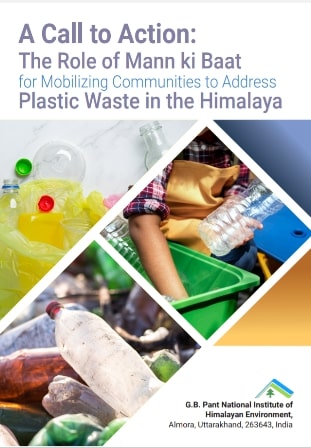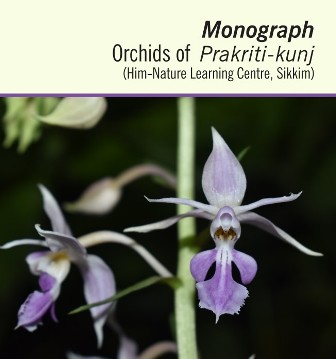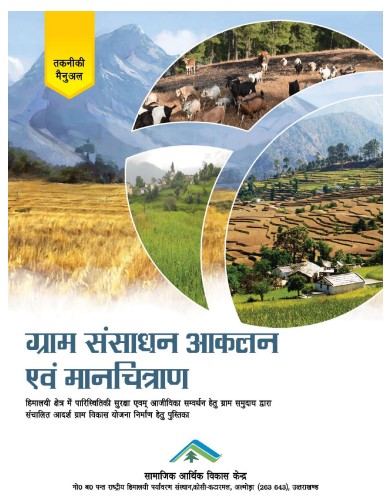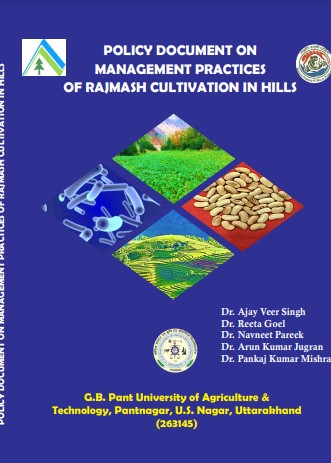Vetiver grass as a nature based solution for soil and water conservation in the Garhwal Himalaya
Authors
Discover Sustainability, 2025
Read
Assessing Hydro-climatological Variability and Land Use Characteristics of the Headwater Basins of the Indian Himalayan Region
Authors
Earth Systems and Environment, 2025
Read
Carrying capacity and strategic planning for sustainable tourism practices in the Char Dham from the Western Himalaya, India
Authors
Scientific Reports, 2025
Read
Evaluation of the phytoremediation potential of Brassica juncea L. for bisphenol A and ibuprofen in contaminated soil
Authors
Plant Physiology and Biochemistry, 2025
Read
Biomass and carbon stock of conifer and broad-leaf forest stands in Talra Wildlife Sanctuary across Northwest Himalayas, India
Authors
Frontiers in Forests and Global Change, 2025
Read
Population status and impact of climate change on the distribution of vulnerable multipurpose plant Hippophae rhamnoides ssp. turkestanica for conservation in Trans-Himalaya, India
Authors
Frontiers in Forests and Global Change, 2025
Read
Population assessment and habitat suitability modelling of endangered medicinal plant, Aconitum heterophyllum Wall. ex Royle in the western Himalaya
Authors
Scientific Reports, 2025
Read
Hydroponic culture improves growth and secondary metabolite production in Rheum tibeticum, a near threatened species from the Ladakh Trans-Himalayan region of India
Authors
Plant Biosystem, 2025
Read
Morphological, physiological and phytochemical variability in Cinnamomum tamala cultivated in two different community lands in Almora district, uttarakhand, India
Authors
Discover Plants, 2025
Read
Comparison of coagulant-induced changes in isoflavone content, and texture profile of Himalayan black soybean-based tofu
Authors
Frontiers in Sustainable Food Systems, 2025
Read
Tailored framework for sustainable intensification of marginal and small farms using farm typology to strengthen farm income
Authors
Environmental and Sustainability Indicators, 2025
Read
Regional Land Surface Conditions Developed Using the High-Resolution Land Data Assimilation System: Challenges Over Complex Orography Himalayan Region
Authors
Meteorological Applications, 2025
Read
The Surface Energy Balance of a Himalayan Mature Pine (Pinus roxburghii) Ecosystem During Drought Stress Conditions
Authors
Meteorological Applications, 2025
Read
Ecosystem-atmosphere exchanges of carbon dioxide, water vapour and energy in India: A synthesis of insights from eddy covariance measurements
Authors
Agricultural and Forest Meteorology, 2025
Read
Grey water treatment and circular economy
Authors
Chemosphere, 2025
Read
Climate-smart and risk-resilient adaptation strategies for potato production: a meta-analysis for South Asia
Authors
Environmental Challenges, 2025
Read
Antioxidant activities and biochemical analysis of Capsicum annuum L. varieties at different ripening stages
Authors
Current Science, 2025
Read
Mainstreaming Glycine soja (Himalayan soybean) a potential underutilized climate resilient crop for nutritional security in the Himalayan region
Authors
3 Biotech , 2025
Read
‘HiFlo-DAT’: A flood hazard event-disaster database for the Kullu District, Himachal Pradesh, Indian Himalaya
Authors
Int. Journal of Disaster Risk Reduction, 2025
Read
Evaluating landuse and climate change effects on current and future hydrologic response and its economic valuation in a North-Indian basin using SWAT
Authors
Sustainable Water Resources Management , 2025
Read
Role of traditional ecological knowledge in shaping climate resilient villages in the Himalaya
Authors
Journal of Environmental Management, 2025
Read
Assessment of Morphology, Ecology, and Distribution Pattern of Malaxis muscifera (Lindl.) Kuntze in Western Himalaya
Authors
Proceedings of the National Academy of Sciences, 2025
Read
Role of traditional ecological knowledge in shaping climate resilient
villages in the Himalaya
Authors
Journal of Environmental Management, 2025
Read
Influence of environmental factors on phytochemical compositions and antioxidant activity of Juniperus communis L
Authors
Discover Environment, 2025
Read
Ethno-medicinal uses, ecology, phytochemistry, biological activities, and conservation approaches for Himalayan Rhubarb species
Authors
Natural Product Research, 2025
Read
Exploring the nutraceutical potential of soybean genotypes of Uttarakhand: implications for the mainstreaming of wild soybean
Authors
Sustainable Food Systems, 2024
Read
Traditional uses, phytochemistry, pharmacology, and nutraceutical potential of horse gram (Macrotyloma uniflorum): A systematic review
Authors
Food Science, 2024
Read
Early signals of climate change impacts on alpine plant
diversity in Indian Himalaya
Authors
Biodiversity and Conservation, 2024
Read
Floristic diversity and species composition along altitudinal gradient in the alpine ecosystem of the cold desert region in Western Himalaya, India
Authors
Frontiers in Plant Science, 2024
Read
Micrometeorological drivers affecting the variability of CO2 uptake in the Himalayan Oak and Pine dominated ecosystems: An assessment of causal relationships
Authors
Journal of Hydrology, 2024
Read
Evaluating tree-ring proxies for representing the ecosystem productivity in India
Authors
International Journal of Biometeorology , 2024
Read
Wet and dry spell induced changes in the soil CO2 effluxes of Pine and Oak ecosystems of Central Himalaya: a comparative assessment for monsoon and winter seasons
Authors
Environmental Monitoring and Assessment, 2024
Read
Enhancing tomato (Solanum lycopersicum) yield and nutrition quality through hydroponic cultivation with treated wastewater
Authors
Food Chemistry, 2024
Read
Strategic engineering for detecting antimicrobial compounds from
Taxus wallichiana Zucc. (Himalayan yew)
Authors
Medicinal Plant Biology, 2024
Read
Nutritional attributes of traditional and commercial apple cultivars growing in West Himalaya, India
Authors
Journal of Food Science and Technology, 2024
Read
Understanding the influence of environmental factors on forest composition along the vertical gradient of Northwestern Himalaya
Authors
Trees, Forests and People, 2024
Read
Income generation potential of backyard poultry in rural areas of Central Himalaya
Authors
World’s Poultry Science Journal, 2024
Read
Cultural ecosystem services nexus with Socio-Cultural attributes and traditional ecological knowledge for managing community forests of indian western Himalaya
Authors
Ecological Indicators, 2024
Read
Deciphering the morphological, phytochemical, genetic diversity, and niche distribution of Allium stracheyi Baker (Amaryllidaceae): An economically important culinary herb of Western Himalaya, India
Authors
South African Journal of Botany, 2024
Read
Passive solar heated buildings for enhancing sustainability in the Indian Himalayas
Authors
Renewable and Sustainable Energy Reviews, 2024
Read
Diversity, distribution and need of urgent conservation
of endemic plants in Himalaya
Authors
Biodiversity and Conservation, 2024
Read
Loss of carbon stock in the forests of Uttarakhand due to unprecedented seasonal forest fires
Authors
Front. For. Glob. Change, 2024
Read
Forest fire management, funding dynamics, and research in the burning frontier: A comprehensive review
Authors
Trees, Forests and People, 2024
Read
Altitudinal Impact on Phytochemical Composition and Mycorrhizal Diversity of Taxus Contorta Griff in the Temperate Forest of Shimla District
Authors
Journal of Basic Microbiology, 2024
Read
Comparative study of phytochemicals and pharmacological properties of different parts of Berberis sikkimensis (C. K. Schneid.) Ahrendt
Authors
Biochemical Systematics and Ecology, 2024
Read
Recent advancements in the physiological, genetic, and genomic research on Rhododendrons for trait improvement
Authors
3 Biotech , 2024
Read
Genetic diversity assessment in medicinal herb Swertia Speciosa (Wall.Ex.D.Don) of higher himalayan region
Authors
Vegetos , 2024
Read
Distribution, Chemical Constituents and Biological Properties of Genus Malaxis
Authors
Chemistry & Biodiversity, 2024
Read
Longitudinal assessment of extreme climate events in Kinnaur district, Himachal Pradesh, north-western Himalaya, India
Authors
Environmental Monitoring and Assessment , 2024
Read
Effect of different extraction solvents on bioactive phenolics and antioxidant potential of Illicium griffithii fruit
Authors
Journal of Applied Research on Medicinal and Aromatic Plants, 2024
Read
Integrating geoenvironmental and socioenvironmental analyses for flood vulnerability assessment in the Kullu Valley, Himachal Pradesh, India
Authors
International Journal of Disaster Risk Reduction, 2024
Read
Biodegradation of Steroid Hormone Estriol by Pseudomonas proteolytica GBPI_Hb61, a Psychrotolerant Himalayan Bacteria
Authors
Water, Air, & Soil Pollution, 2024
Read
Chemical composition and biological activities of Pittosporum eriocarpum Royle: an unexplored medicinal plant of Indian himalayan region
Authors
Natural Product Research, 2024
Read
Assessing the state, parameter-interlinkages and dynamic shift of glaciers in the western Himalaya
Authors
Cold Regions Science and Technology, 2024
Read
Annual velocities of the ablation zone of Panchi Nala Glacier, western Himalaya: Trends and controlling factors
Authors
Polar Science, 2024
Read
Surface facies analysis of the Gangotri and neighbouring glaciers, central Himalaya
Authors
Science of Remote Sensing, 2024
Read
Glacier mass balance and its climatic and nonclimatic drivers in the Ladakh region during 2000–2021 from remote sensing data
Authors
Journal of Glaciology, 2024
Read
Endophytic fungi from Himalayan silver birch as potential source of plant growth enhancement and secondary metabolite production
Authors
Brazilian Journal of Microbiology, 2024
Read
Rarities pattern of vascular plants in the high-altitude forests of Indian western Himalaya: Conservation implications
Authors
Journal for Nature Conservation, 2024
Read
Spatially Explicit climate change vulnerability assessment of ecological systems along altitudinal gradients in the Indian Himalayan region
Authors
Environmental and Sustainability Indicators, 2024
Read
Elevation gradients alter vegetation attributes in mountain ecosystems of eastern Himalaya, India
Authors
Frontiers in Forests and Global Change, 2024
Read
Assessing the global distribution and conservation status of the Taxus genus: An overview
Authors
Trees, Forests and People, 2024
Read
Elevation determines the productivity of large cardamom (Amomum subulatum Roxb.) cultivars in Sikkim Himalaya
Authors
Scientific Reports, 2023
Read
Elicitor-induced phytochemicals production in Berberis lycium Royle
Authors
Industrial Crops and Products, 2023
Read
Effect of forest fire on tree diversity and regeneration in the forests of Uttarakhand, Western Himalaya, India
Authors
Frontiers in Forests and Global Change, 2023
Read
In vitro Propagation of Endemic Species Mahonia
Jaunsarensis Ahrendt Through Callus Culture
Authors
Applied Biochemistry and Biotechnology, 2023
Read
Hydrometeorological factors affecting the carbon exchange of the Himalayan pine-dominated ecosystem
Authors
Ecological Informatics, 2023
Read
Potent multi-target natural inhibitors against SARS-CoV-2 from medicinal plants of the Himalaya: a discovery from hybrid machine learning, chemoinformatics, and simulation assisted screening
Authors
Journal of Biomolecular Structure and Dynamics, 2023
Read
Forest dynamics along altitudinal gradient covering treeline ecotone
of Indian Western Himalaya
Authors
Biologia , 2023
Read
Long-term ecological monitoring and observation: a review in the context of Indian Himalaya
Authors
Current Science, 2023
Read
Supraglacial geomorphology of Companion Glacier, central Himalaya: evolution, controls and consequences
Authors
Frontiers in Earth Science, 2023
Read
On periodic growth and shrinkage of glaciers in the Warwan
sub‐basin, western Himalaya, between 1990 and 2020
Authors
Environmental Monitoring and Assessment, 2023
Read
Ethnobotanical knowledge and socio-ecological significance of vernacular architecture of Adi community of Arunachal Himalaya in North-Eastern India
Authors
Indian Journal of Traditional Knowledge, 2023
Read
Nature-based solutions in Hindu Kush Himalayas: IUCN global standard based synthesis
Authors
Ecological Indicators, 2023
Read
Comparative assessment of morphological, physiological and
phytochemical attributes of cultivated Valeriana jatamansi Jones in
Uttarakhand, West Himalaya
Authors
Plant Physiology and Biochemistry , 2023
Read
Morphological, Nutritional, Chemical and Antioxidant Potential of Mahonia Jaunsarensis Ahrendt Fruit: A Narrow Endemic Wild Edible Species of Western Himalaya
Authors
International Journal of Fruit Science, 2023
Read
Antioxidant Properties and Polyphenolics of Berberis Lycium: An Unexplored Wild Edible Fruit Species of Himalaya
Authors
National Academy Science Letters , 2023
Read
Impact of monsoon season rainfall spells on the ecosystem carbon exchanges of Himalayan Chir-Pine and Banj-Oak-dominated forests: a comparative assessment
Authors
Environmental Monitoring and Assessment, 2023
Read
Is survival of Himalayan Cedar (Cedrus deodara) threatened? An evaluation based on predicted scenarios of its growth trend under future climate change
Authors
Science of The Total Environment, 2023
Read
Effect of dehulling, roasting, and cooking on the nutritional composition of Himalayan barnyard millet (Echinochloa frumentacae)
Authors
JSFA Reports, 2023
Read
Geochemical characteristics and suspended sediments dynamics in the meltwater from the Gangotri Glacier, Garhwal Himalaya, India
Authors
Environmental Earth Sciences, 2023
Read
Very high-resolution Net Ecosystem Exchange over India using Vegetation Photosynthesis and Respiration Model (VPRM) simulations
Authors
Ecological Modelling, 2023
Read
Growth of water hyacinth biomass and its impact on the floristic composition of aquatic plants in a wetland ecosystem of the Brahmaputra floodplain of Assam, India
Authors
AQUATIC BIOLOGY, 2023
Read
Assessing the impacts of current and future changes of the planforms of river Brahmaputra on its land use-land cover
Authors
Geoscience Frontiers, 2023
Read
Elevation, aspect, and habitat heterogeneity determine plant diversity and compositional patterns in the Kashmir Himalaya
Authors
Frontiers in Forests and Global Change, 2023
Read
Multifactor prediction of the central Himalayan spring high-flows using machine learning classifiers
Authors
Environmental Earth Sciences, 2023
Read
Plant species diversity and density patterns along altitude gradient covering high-altitude alpine regions of west Himalaya, India
Authors
Geology, Ecology, and Landscapes, 2023
Read
Tree rings of Rhododendron arboreum portray signal of monsoon precipitation in the Himalayan region
Authors
Frontiers in Forests and Global Change, 2023
Read
Litter decomposition of Chir-Pine (Pinus roxburghii Sarg.) in the Himalayan region
Authors
Trees, Forests and People, 2022
Read
Geospatial modeling to assess the past and future land use-land cover changes in the Brahmaputra Valley, NE India, for sustainable land resource management
Authors
Environmental Science and Pollution Research, 2022
Read
Land Use and Land Cover Change Monitoring and Prediction of a UNESCO World Heritage Site: Kaziranga Eco-Sensitive Zone Using Cellular Automata-Markov Model
Source dependent variation in phenolics, antioxidant and antimicrobial activity of Paeonia emodi in west Himalaya, India
Authors
Physiology and Molecular Biology of Plants, 2022
Read
Water–energy, climate, and habitat heterogeneity mutually drives spatial pattern of tree species richness in the Indian Western Himalaya
Authors
Frontiers in Forests and Global Change, 2022
Read
Seeing from space makes sense: Novel earth observation variables accurately map species distributions over Himalaya
Authors
Journal of Environmental Management, 2022
Read
Vegetation dynamics and soil nutrient availability in a temperate forest along altitudinal gradient of Nanda Devi Biosphere Reserve, Western Himalaya, India
Authors
PLOS ONE, 2022
Read
Pharmacological and phytochemical potential of Rubus ellipticus : a wild edible with multiple health benefits
Authors
Journal of Pharmacy and Pharmacology, 2022
Read
Sesquiterpenoid lactones as potential anti-cancer agents: an update on molecular mechanisms and recent studies
Authors
Cancer Cell International , 2022
Read
Land restoration in the Himalayan Region: Steps towards
biosphere integrity
Authors
Land Use Policy, 2022
Read
Conservation Priority Index of species, communities, and habitats for biodiversity conservation and their management planning: A case study in Gulmarg Wildlife Sanctuary, Kashmir Himalaya
Authors
Frontiers in Forests and Global Change, 2022
Read
Scientific research in the Himalaya: Current state of knowledge, funding paradigm and policy implications
Authors
Environmental Science & Policy, 2022
Read
Integrated remote sensing and field-based approach to assess the temporal evolution and future projection of meanders: A case study on River Manu in North-Eastern India
Authors
PLOS ONE, 2022
Read
Influence of Anthropogenic Pressure on the Plant Species Richness and Diversity Along the Elevation Gradients of Indian Himalayan High-Altitude Protected Areas
Authors
Frontiers in Ecology & Evolution, 2022
Read
Landscape level ecological assessment and eco-restoration strategies for alpine and sub-alpine regions of the Central Himalaya
Authors
Ecological Engineering, 2022
Read
Assessment of genetic diversity, population structure and phytochemical variations in Polygonatum cirrhifolium (Wall.) Royle: an endangered medicinal herb
Authors
Genetic Resources and Crop Evolution, 2022
Read
Genetic variations and population level admixture assessment for conservation planning of endangered Zanthoxylum armatum DC. in Western Himalaya
Authors
Genetic Resources and Crop Evolution, 2022
Read
Biodegradation of bisphenol A using psychrotolerant bacterial strain Pseudomonas palleroniana
Authors
Archives of Microbiology , 2022
Read
Floristic diversity in Cold Desert regions of Uttarakhand Himalaya, India
Authors
Phytotaxa, 2022
Read
Maling bamboo (Yushania maling) overdominance alters forest structure and composition in Khangchendzonga landscape, Eastern Himalaya
Authors
Scientific Reports, 2022
Read
Vertical structures of winter-season stratiform rainfall over central Himalaya
Authors
Meteorology and Atmospheric Physics, 2022
Read
Comparative nutritional and antimicrobial analysis of Himalayan black and yellow soybean and their okara
Authors
Journal of the Science of Food and Agriculture, 2022
Read
Is tree ring chronology of blue pine (Pinus wallichiana A. B. Jackson) prospective for summer drought reconstruction in the Western Himalaya?
Authors
Journal of Asian Earth Sciences, 2022
Read
Age Dependent Growth Response of Cedrus Deodara to Climate Change in Temperate Zone of Western Himalaya
Authors
Trees, Forests and People, 2022
Read
Mammalian Research, Diversity and Conservation in the Far Eastern Himalayan Landscape: A Review
Authors
Global Ecology and Conservation, 2022
Read
Aerosol Characteristics and Their Impact on the Himalayan Energy Budget
Authors
Sustainability, 2021
Read
Computational investigation of drug bank compounds against 3C-like protease (3CLpro) of SARS-CoV-2 using deep learning and molecular dynamics simulation
Authors
Molecular Diversity, 2021
Read
In silico screening of natural compounds to inhibit interaction of human ACE2 receptor and spike protein of SARS-CoV-2 for the prevention of COVID-19
Authors
Journal of Biomolecular Structure and Dynamics, 2021
Read
Key roles for the freezing line and disturbance in driving the low plant species richness of temperate regions
Authors
Global Ecology and Biogeography, 2021
Read
Process optimization and bioactive compounds quantification from Dactylorhiza hatagirea tuber for alleviating glycemic and oxidative stress
Authors
Journal of Applied Research on Medicinal and Aromatic Plants, 2021
Read
Tree biomass and carbon stock assessment of subtropical and temperate forests in the Central Himalaya, India
Authors
Trees, Forests and People, 2021
Read
Optimized extraction of polyphenolic antioxidants from the leaves of Himalayan Oak species
Authors
PLOS ONE, 2021
Read
Influence of environmental factors on tree species diversity and composition in the Indian western Himalaya
Authors
Forest Ecology and Management, 2021
Read
Temporal changes in Oak forests over last three decades in western Himalaya, India
Authors
Trees, Forests and People, 2021
Read
Rejuvenating ecosystem services through reclaiming degraded land for sustainable societal development: Implications for conservation and human wellbeing
Authors
Land Use Policy, 2021
Read
Morphological, phytochemical and genetic diversity of threatened Polygonatum verticillatum (L.) All. populations of different altitudes and habitat types in Himalayan region
Authors
Physiology and Molecular Biology of Plants, 2021
Read
Microbial Degradation of Caffeine Using Himalayan Psychrotolerant Pseudomonas sp.GBPI_Hb5 (MCC 3295)
Authors
Current Microbiology, 2021
Read
Projected changes in winter-season wet days over the Himalayan region during 2020–2099
Authors
Theoretical and Applied Climatology, 2021
Read
Impacts of terrain on convective surface layer turbulence over central Himalaya based on Monin–Obukhov similarity theory
Authors
Journal of Atmospheric and Solar-Terrestrial Physics, 2021
Read
Predicting the distributional range shifts of Rhizocarpon geographicum (L.) DC. in Indian Himalayan Region under future climate scenarios
Authors
Environmental Science and Pollution Research, 2021
Read
Predicting the current and future suitable habitat distribution of the medicinal tree Oroxylum indicum (L.) Kurz in India
Authors
Journal of Applied Research on Medicinal and Aromatic Plants , 2021
Read
A Review of Two Decades of Conservation Efforts on Tigers, Co-Predators and Prey at the Junction of Three Global Biodiversity Hotspots in the Transboundary Far-Eastern Himalayan Landscape
Authors
Animals, 2021
Read
Ageratina adenophora and Lantana camara in Kailash Sacred Landscape, India: Current distribution and future climatic scenarios through modeling
Authors
PLOS ONE, 2021
Read
Bioactive compounds and biological activities of Elaegnus latifolia L.: An underutilized fruit of North-East Himalaya, India
Authors
South African Journal of Botany, 2021
Read
Reconstruction of pre-monsoon relative humidity since 1800 C.E. based on tree-ring data of Pinus roxburghii Sarg. (chir–pine) from Pithoragarh, Western Himalaya
Authors
Quaternary International, 2021
Read
Scoping the Need of Mainstreaming Indigenous Knowledge for Sustainable Use of Bioresources in the Indian Himalayan Region
Authors
Environmental Management, 2021
Read
Spatial forest vulnerability profile of major forest types in Indian Western Himalaya
Authors
Forest Ecology and Management, 2021
Read
Ecological condition and management status of Community Forests in Indian western Himalaya
Authors
Elsevier , 2021
Read
2021, VOL. 3, ISSUE 2 Prospects of organic tea cultivation in Uttarakhand hills, India
Authors
International Journal of Environmental and Ecology Research, 2021
Read
Changing Outlook on Harnessing Biodiversity Values – A Special Focus on Indian Himalaya
Authors
Journal of Graphic Era University, 2021
Read
Nonlinear recurrence quantification of the monsoon-season heavy rainy-days over northwest Himalaya for the baseline and future periods
Authors
Science of The Total Environment , 2021
Read
Ecosystem-atmosphere carbon and water exchanges of subtropical evergreen and deciduous forests in India
Authors
Forest Ecology and Management , 2021
Read
Population status, threats, and conservation options of the orchid Dactylorhiza hatagirea in Indian Western Himalaya
Authors
Regional Environmental Change, 2021
Read
Nutritional Composition of Seed Kernel and Oil of Wild Edible Plant Species from Western Himalaya, India
Authors
International Journal of Fruit Science, 2021
Read
Impact of terrain complexity on the turbulence drag coefficient: a case study from the Indian Himalayan region
Authors
Dynamics of Atmospheres and Oceans, 2021
Read
Soil macrofauna diversity and population dynamics in Indian Himalayan agroecosystems
Authors
Soil Research, 2021
Read
Soil nutrients concentration along altitudinal gradients in Indian Western Himalaya
Authors
Scandinavian Journal of Forest Research, 2021
Read
Phytosociological and niche distribution study of Paris polyphylla smith, an important medicinal herb of Indian Himalayan region
Authors
Tropical Ecology, 2021
Read
Climate Change Observations of Indigenous Communities in the Indian Himalaya
Authors
Weather, Climate, and Society, 2021
Read
200 Years of Research on Himalayan Biodiversity: Trends, Gaps, and Policy Implications
Authors
Frontiers in Ecology & Evolution, 2021
Read
Expansion of a native species and its impacts on alpine ecosystems, Indian Himalaya
Authors
Biologia, 2021
Read
Soil macrofauna diversity and population dynamics in Indian Himalayan agroecosystems
Authors
Soil Research, 2020
Read
Optimized microwave assisted extraction (MAE) of alkaloids and polyphenols from Berberis roots using multiple-component analysis
Authors
Scientific Reports, 2020
Read
Assessment of New Alternative Scaling Properties of the Convective Boundary Layer: Application to Velocity and Temperature Spectra
Authors
Boundary-Layer Meteorology, 2020
Read
Identification of luteolin -7-glucoside and epicatechin gallate from Vernonia cinerea, as novel EGFR L858R kinase inhibitors against lung cancer: Docking and simulation-based study
Authors
Journal of Biomolecular Structure and Dynamics, 2020
Read
Development of polymorphic EST-SSR markers and their applicability in genetic diversity evaluation in Rhododendron arboreum
Authors
Molecular Biology Reports, 2020
Read
Cross-transferability of SSR markers developed in Rhododendron species of Himalaya
Authors
Molecular Biology Reports, 2020
Read
Essential oil composition, phenolics and antioxidant activities of Valeriana jatamansi at different phenological stages
Authors
Plant Biosystems, 2020
Read
Diabetes and plant-derived natural products: From ethnopharmacological approaches to their potential for modern drug discovery and development
Authors
Phytotherapy Research, 2020
Read
Virtual screening of anti-HIV1 compounds against SARS-CoV-2: machine learning modeling, chemoinformatics and molecular dynamics simulation based analysis
Authors
Scientific Reports, 2020
Read
Influence of altitude on secondary metabolites, antioxidants, and antimicrobial activities of Himalayan yew (Taxus wallichiana)
Authors
Plant Biosystems, 2020
Read



















